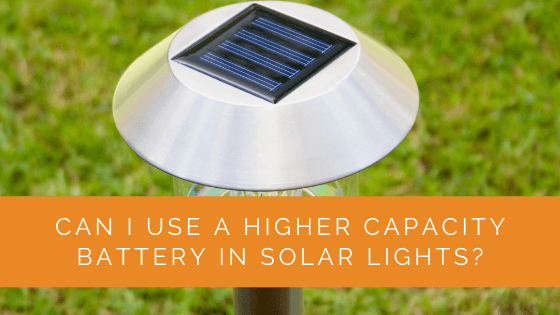As we embrace the era of renewable energy, solar lights have become integral to our lives, providing eco-friendly illumination for our outdoor spaces. While these lights come with standard batteries, many wonder if they can use higher-capacity batteries to enhance performance. The answer is yes, you can indeed opt for higher capacity batteries, but there are crucial considerations to remember.
The capacity of solar light batteries plays a pivotal role in determining their efficiency and longevity. This comprehensive guide will delve into the intricacies of using higher-capacity batteries in solar lights. Before making this decision, we will explore the advantages and disadvantages, battery types, and essential factors. So, let’s illuminate the path to a brighter and more energy-efficient outdoor lighting experience.
Contents
- 1 Key Takeaways
- 2 Can I Use Higher Capacity Solar Light Batteries?
- 3 Factors to Consider Before Changing the Battery in Solar Lights
- 4 Advantages of Choosing a Higher mAh Battery in Solar Lights
- 5 Disadvantages of Choosing a Higher mAh Battery
- 6 Choosing the Right Rechargeable Batteries
- 7 FAQ
- 8 Examples of Solar Lights
- 9 Our Expertise in Solar Lights
- 10 Wrapping Up
Key Takeaways
- You can use a higher-capacity battery in your solar lights, but it should closely match your existing battery’s specifications to avoid voltage issues.
- Choosing the right rechargeable battery for your solar lights involves considering factors like capacity (mAh), battery type, size, voltage, recharge cycle, and self-discharge rate.
- Using a higher-capacity battery can extend the working hours of your solar lights, especially during cloudy days. Still, it may also lead to longer charging times and potential energy wastage.
Can I Use Higher Capacity Solar Light Batteries?
The simple answer is yes, and you can use a battery with higher capacity in your solar lights. However, it would be best to remember that most solar lights include batteries with an average capacity of 1000-3000mAh. This is sufficient to last through the day.
Now, when it comes to the capacity of the batteries of the solar lights, you can choose one with a slightly higher capacity, say around 1500mAh. However, if you intend to use a battery with a considerably higher capacity, like around 2400mAh, for example, it can be a waste.
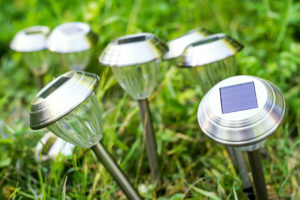 How so, you may ask! The answer is that you will not be able to use the full charge within a day, and most of it will go to waste. Therefore, it is better to consider investing in unused battery capacity.
How so, you may ask! The answer is that you will not be able to use the full charge within a day, and most of it will go to waste. Therefore, it is better to consider investing in unused battery capacity.
Moreover, it would be best to avoid purchasing batteries from unreliable sources or lesser-known brands. The reason is that these products may not produce the same mAh as mentioned on the packaging. This will further result in a shorter working time for your solar lights.
In the end, the battery capacity does play a significant role in powering your solar lights. If you wondered why your solar lights are starting to look like dim light as days pass, the rechargeable battery could be.
Now, solar lights usually consist of a few important components. These include:
- The photovoltaic cell or solar array
- Charge controller
- LED (Light Emitting Diode)
- A rechargeable battery
Your solar lights function the best when all these components come into play. So, let’s have a detailed look at the rechargeable battery.
Factors to Consider Before Changing the Battery in Solar Lights
So, when choosing the battery for your solar lights, capacity is not the only factor to consider. Rechargeable batteries vary from one another based on various characteristics.
- These could be:
- Chemical composition (Li-Ion, Li-Ion Polymer, NiCD, and NiMH batteries)
- Size and shape
- Recharge rate
- Discharge rate
- Capacity measured in milli-Ampere-hours (mAh)
The mAh ratings of the Rechargeable Batteries in Solar Lights
When choosing rechargeable batteries, the capacity (mAh) is one of the main characteristics. This rating denotes the charge the battery can store within its cells. Usually, the mAh rating is given by milli-ampere-hours (mAh) or Ampere-hours (Ah).
This is also why the battery capacity is often termed as mAh. Usually, batteries with low capacity are denoted by the mAh rating, while the larger ones use the Ah rating.
Types of Battery Used in Solar Lights
The primary role of a battery in solar lights is to store the electric energy the solar panels convert. However, the batteries used by solar lights can differ.
Lead-acid battery and SMF
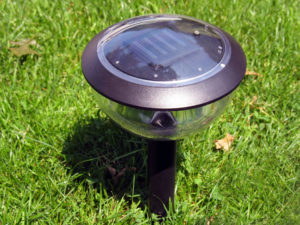 Lead-acid batteries are most popular among users because of their inexpensive nature compared to the new technology batteries. These batteries are useful for various applications. They are also available in multiple sizes.
Lead-acid batteries are most popular among users because of their inexpensive nature compared to the new technology batteries. These batteries are useful for various applications. They are also available in multiple sizes.
These batteries are sealed maintenance-free (SMF) and are highly resistant to overcharging. There is also a meager amount of self-discharge due to the SMF aspect. However, you need to maintain these batteries to avoid the risk of explosion regularly. In addition, lead can also cause environmental hazards, especially under extreme weather conditions.
Lithium-ion batteries (Li-ion batteries)
Li-ion batteries are very compact but cost much more than lead-acid regular batteries. You will usually see these special batteries being used in mobile phones, digital cameras, and laptops. They need 3.7V of power to charge.
Therefore, these batteries will work better with smaller solar panels. The best part about these batteries is that the solar panel can generate the power needed to charge the batteries even during cloudy conditions.
Lithium iron phosphate (LiFePO4)
LiFePO4 batteries are compact as well and highly portable. The technology used in these batteries is widely compatible with most modern electronic gadgets. As you can see, this is the most advanced type of battery available today.
NiMH batteries and NiCd batteries
These can be used with smaller solar panels and perform well during cloudy days. However, these are the most expensive battery types there are.
Now, your garden solar lights only use two types of batteries: (Nickel Metal Hydride) NiMH and NiCD batteries (Nickel Cadmium).
- NiCd batteries are more harmful as they contain the dangerous element Cadmium.
- NiMH rechargeable batteries or nickel-metal hydride is a clear winner since they can store twice the solar energy compared to NiCd batteries.
Note:
You can even use the non-rechargeable regular batteries to test your solar light’s LED. But otherwise, do not put non-rechargeable regular batteries in your garden solar lights.
Size of the batteries in Solar Lights
Size is another factor you must consider before changing your solar lights’ battery. This includes the physical dimensions of the batteries in their literal sense. Since rechargeable batteries come in various shapes and sizes, it is important to understand those.
The most common sizes of rechargeable batteries include:
- AAA
- AA
- 14500
- 16340
- 18650
- 2660
- Coin Cell
- D cell
- C cell
Now, even solar lights are available in various shapes and sizes. Depending on that, the size of the rechargeable battery also needs to comply. Therefore, before making any changes, you must ensure that the replaced battery matches that standard.
The Voltage of the Battery
Whether you replace the old batteries for solar lights with a higher mAh battery or not, you need to consider this factor the most. The maximum voltage of the battery ensures it can handle enough power. The voltage rating of the LEDs primarily determines this.
Before changing the standard batteries, you must ensure that the new batteries do not exceed the maximum ratings. If not paid attention, this could damage the other components of your solar light. Simultaneously, a low-voltage battery will not provide the power necessary for running the LEDs to light up your outdoors.
Recharge Cycle
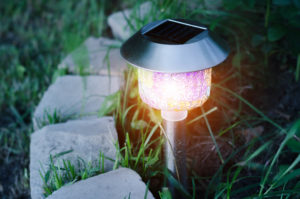 The recharge cycle or cyclic life denotes the lifespan of a solar light battery. Usually, a flooded battery can last up to 300 to 700 cycles under normal usage. On average, that can last around 1-2 years. However, the actual lifespan may vary from the theoretical number based on type and quality.
The recharge cycle or cyclic life denotes the lifespan of a solar light battery. Usually, a flooded battery can last up to 300 to 700 cycles under normal usage. On average, that can last around 1-2 years. However, the actual lifespan may vary from the theoretical number based on type and quality.
For instance, you may try to find rechargeable batteries with a recharge cycle of 1000 at least for better and long-lasting performance of your solar light.
Self-Discharge Rate
Batteries lose a certain amount of charge, even when left unused. The self-discharge rate denotes this. The range can vary between 80% and 100%, yielding above the output voltage rating. However, the voltage can drop pretty quickly.
This means the battery would need a voltage boost for a short period, even if it is charged at 100%. On the other hand, a self-discharge rate range between 40% and 80% is considered more stable with only a 0.5 Volt drop. Therefore, choose a battery that can retain 70% of its charge for up to three years when unused.
Advantages of Choosing a Higher mAh Battery in Solar Lights
The role of the battery in a solar light system is primarily to store electric energy. The solar panel converts This energy from solar power during the daytime. Later, after sunset, this is the energy that helps illuminate your light sources.
Now, using a higher-capacity battery does come with some notable advantages.
- An increased mAh automatically increases the work time hours of the LED. Solar lights usually come with low-mAh batteries that last an hour or two. Therefore, a higher mAh battery can keep the lights on overnight.
- Sunshine is unavailable in the same amount on all days, as the next day could be cloudy. A larger battery could help store more energy to sustain through cloudy days. But you must ensure the solar light LEDs do not consume too much power.
Disadvantages of Choosing a Higher mAh Battery
Similarly, using batteries with larger mAh has some significant disadvantages as well.
- A battery with higher mAh will take longer to be charged to its total capacity. If you intend to store the energy another day, this will happen.
- Even the solar panel needs to accommodate enough current to charge the batteries. After all, the sun remains for only a limited period.
- In addition, the sun changes its position throughout the day. So, you must pay attention and position the solar light constantly. Otherwise, the battery will not get the necessary amount of light.
Choosing the Right Rechargeable Batteries
In the end, it can be said that you can replace your 400mAh solar light battery with a higher capacity. However, before you make the call, ensure that the battery matches the specifications of your solar light. For this, you need to refer to the various factors mentioned above.
FAQ
Can you use 600mAh instead of 300mAh rechargeable batteries?
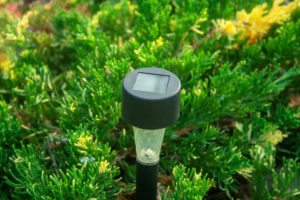 Yes, you can replace your solar light’s battery with one with a slightly different or higher capacity. The only concern is the voltage. It would be best to always choose replacement batteries with a mAh rating close to your existing batteries.
Yes, you can replace your solar light’s battery with one with a slightly different or higher capacity. The only concern is the voltage. It would be best to always choose replacement batteries with a mAh rating close to your existing batteries.
What happens if I use higher mAh rechargeable batteries?
The primary change you will notice is that your solar lights will last much longer than usual. Therefore, increasing the work time of your existing solar lights is an excellent tactic. However, without proper planning, a lot of energy might be wasted, not to mention an increased charging time.
Can I use 600mAh instead of 400mAh rechargeable batteries?
Using a 600 mAh battery instead of a 400 mAh battery in solar lights will make the solar lights stay on longer. However, it will not make the lights shine brighter than their full capacity. Moreover, it will take longer to charge the 600mAh battery to its full power compared to a 400mAh one.
Can I use 800mAh instead of 400mAh rechargeable batteries on solar lights?
Yes, you can. The only concern is ensuring the plug on your solar lights and the batteries match.
Examples of Solar Lights
- Solar Driveway Lights: https://us.solarpanelsnetwork.com/blog/best-solar-driveway-lights/
- Solar Flood Lights: https://us.solarpanelsnetwork.com/blog/best-solar-flood-lights/
- Solar Spotlights: https://us.solarpanelsnetwork.com/blog/best-solar-spotlights/
- Solar Street Lights: https://us.solarpanelsnetwork.com/blog/best-solar-street-lights/
- Solar Wall Lights: https://us.solarpanelsnetwork.com/blog/best-solar-wall-lights/
Our Expertise in Solar Lights
At Solar Panels Network USA, we’re here to provide you with valuable information and support regarding solar lighting. With our experience and understanding of the solar lighting industry, our team of experts is prepared to assist you in finding the right lighting solution for your needs. Whether you’re interested in improving your outdoor spaces, conserving energy, or adopting a more sustainable approach, we’re well-equipped to help. Please feel free to contact us with any questions or inquiries.
Wrapping Up
It can be said that development and research in the solar industry aim to reduce costs and increase efficiency. With more manufacturers becoming competitive, you can find many options.
You can always go for a battery with higher capacity as a replacement, but make sure you understand the factors for choosing them. Also, keeping disadvantages in mind will help you avoid such situations.
About the Author
Solar Panels Network USA stands at the forefront of solar energy solutions, driven by a team of seasoned solar engineers and energy consultants. With over decades of experience in delivering high-quality solar installations and maintenance, we are committed to promoting sustainable energy through customer-centric, tailored solutions. Our articles reflect this commitment, crafted collaboratively by experts to provide accurate, up-to-date insights into solar technology, ensuring our readers are well-informed and empowered in their solar energy decisions.

